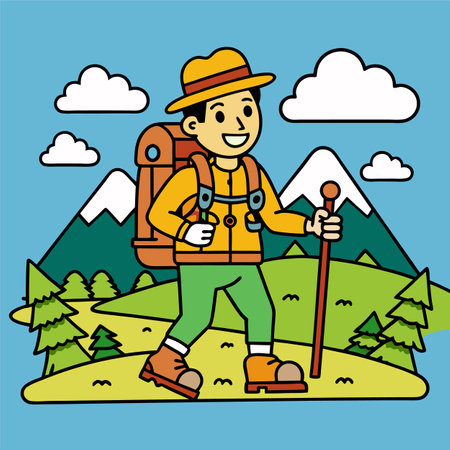1. Why a Dutch Oven is a Camper’s Best Friend
When it comes to cooking lunch in the great outdoors, few tools are as reliable and versatile as the Dutch oven. This rugged, heavy-duty pot has been a favorite among campers for generations—and for good reason. Whether youre simmering chili, baking cornbread, or slow-cooking pulled pork, a Dutch oven can handle it all with ease.
The Versatility of a Dutch Oven
One of the biggest reasons campers swear by their Dutch ovens is their ability to cook just about anything. From hearty stews to baked goods, this cookware adapts to whatever recipe you throw at it. You can use it over an open flame, nestled into hot coals, or even on a camp stove.
What You Can Cook with a Dutch Oven
| Meal Type | Examples |
|---|---|
| Soups & Stews | Beef stew, chicken noodle soup |
| Baked Dishes | Cornbread, biscuits, cobblers |
| Main Courses | Pulled pork, lasagna, chili |
| One-Pot Meals | Mac and cheese, jambalaya |
Durability That Lasts for Years
Dutch ovens are built tough—usually made from cast iron—which means they can withstand high heat and rough handling. With proper care (like seasoning and avoiding soap when cleaning), your Dutch oven could last for decades. Some campers even pass theirs down through generations!
Ease of Use in Outdoor Settings
You don’t need to be a gourmet chef to make amazing meals with a Dutch oven. Its thick walls and tight-fitting lid help distribute heat evenly, making it forgiving for beginner cooks. Plus, you can prep your ingredients ahead of time at home and simply dump them in while at camp—super convenient for midday meals.
Pro Tip:
Use charcoal briquettes for more controlled cooking temperatures. Place some under the pot and some on the lid to mimic an oven-like environment.
A Must-Have in Your Camp Kitchen Gear
If you’re serious about camping lunches that go beyond PB&J or canned soup, investing in a good Dutch oven is a game-changer. It opens up endless possibilities for tasty, filling meals that fuel your adventures—all while adding rustic charm to your outdoor experience.
2. Campfire Setup and Dutch Oven Essentials
Before you start cooking a delicious Dutch oven lunch at your campsite, its important to get your fire or charcoal setup just right. A good heat source is the foundation of successful outdoor cooking. Heres how to set things up for tasty, evenly-cooked meals every time.
Building the Perfect Campfire for Cooking
If youre using a traditional campfire instead of charcoal briquettes, youll want to build a fire that produces hot coals rather than big flames. Follow these steps for an ideal cooking fire:
- Choose a Safe Spot: Use an existing fire ring if available. Make sure its clear of overhanging branches and dry brush.
- Start with Kindling: Use small sticks, dry leaves, and twigs to get your fire going.
- Add Medium Logs: Once your kindling catches, add medium-sized logs to build up heat.
- Create Hot Coals: Let the fire burn down for about 30–45 minutes until you have a solid bed of glowing coals perfect for Dutch oven cooking.
Charcoal Setup for Consistent Heat
If you prefer more control over your cooking temperature, charcoal briquettes are a great option. Use this guide to determine how many briquettes youll need based on your Dutch oven size and desired heat level:
| Dutch Oven Size | Total Briquettes | Top Lid | Bottom |
|---|---|---|---|
| 10-inch Oven (350°F) | 23 | 15 | 8 |
| 12-inch Oven (350°F) | 27 | 18 | 9 |
| 14-inch Oven (350°F) | 33 | 22 | 11 |
This setup helps maintain an even temperature throughout the cooking process. Adjust the number of briquettes depending on weather conditions—windy or cold days may require a few extras.
Must-Have Dutch Oven Tools & Accessories
Cooking with a Dutch oven while camping is easier and safer when you have the right gear. Heres a list of essential items every camper should bring along:
- Lid lifter: Helps you safely remove the hot lid without burning yourself.
- Heat-resistant gloves: Protect your hands when handling hot cast iron.
- Charcoal chimney starter: Quickly lights your briquettes without lighter fluid.
- Dutch oven stand or trivet: Keeps your oven stable above hot coals or flame.
- Tongs and spatula: For flipping and serving food easily inside the oven.
- Casting iron cleaner or scraper: Makes cleaning up much easier after meals.
Bonus Tip:
A simple metal shovel is handy for moving hot coals around and creating even heat under and over your Dutch oven.
Safety First!
No matter what fuel source you use, always follow these basic safety tips:
- Never leave a fire unattended.
- Keep water or sand nearby in case you need to put out flames quickly.
- Avoid placing your Dutch oven directly on burning flames; always cook with coals or briquettes for better control.
- Let all equipment cool before handling or packing it away.
A solid campfire setup and the right tools make all the difference when preparing lunch with a Dutch oven in the great outdoors. With these essentials in place, youre well on your way to crafting hearty, flavorful meals no matter where your adventure takes you.

3. Easy and Flavor-Packed Dutch Oven Lunch Recipes
When youre out in the wild, you want lunch to be hearty, satisfying, and simple to make. That’s where the Dutch oven really shines—it locks in flavor, handles high heat like a champ, and makes one-pot meals a breeze. Whether youre just getting into camping or youre a seasoned outdoor chef, these go-to Dutch oven lunch recipes will keep everyone at your campsite full and happy.
🔥 Campfire Chili
This classic is a favorite for a reason—its rich, comforting, and can feed a crowd. Just brown your ground beef or turkey right in the Dutch oven, toss in canned beans, tomatoes, chopped onions, garlic, and your favorite chili seasoning. Let it simmer over the coals while you kick back.
Simple Ingredients:
| Ingredient | Amount |
|---|---|
| Ground beef or turkey | 1 lb |
| Canned kidney beans | 2 cans |
| Diced tomatoes | 2 cans |
| Onion (chopped) | 1 medium |
| Garlic (minced) | 2 cloves |
| Chili seasoning mix | 1 packet or homemade blend |
🧀 Loaded Mac and Cheese
This isn’t your basic boxed mac. Start by boiling elbow macaroni in the Dutch oven until tender. Drain the water, then stir in shredded cheddar cheese, cream, cooked bacon bits, and a dash of garlic powder. Let it melt into gooey perfection over low heat.
Simple Ingredients:
| Ingredient | Amount |
|---|---|
| Elbow macaroni | 2 cups dry |
| Cheddar cheese (shredded) | 2 cups |
| Heavy cream or milk | 1/2 cup |
| Bacon bits (cooked) | 1/2 cup |
| Garlic powder | 1 tsp |
| Salt & pepper to taste | – |
🥘 Cowboy Stew
This rustic dish is perfect for chilly afternoons on the trail. It’s a mix between stew and chili, loaded with sausage, potatoes, beans, corn, and spicy tomato broth. Brown your sausage first, then add everything else and let it cook down until thick and hearty.
Simple Ingredients:
| Ingredient | Amount |
|---|---|
| Sausage links (sliced) | 1 lb |
| Diced potatoes (skin-on) | 2 cups |
| Canned pinto beans | 1 can |
| Corn kernels (drained if canned) | 1 cup |
| Diced tomatoes with green chiles (Rotel style) | 1 can |
| Paprika & cumin for flavoring | To taste |
TIPS FOR SUCCESS:
- Add wood chips or charcoal around your Dutch oven lid for even heat from above.
- Avoid opening the lid too often—this keeps the heat consistent and flavors locked in.
- If you’re short on time at camp, pre-chop veggies at home and store them in zip bags.
- Bake some cornbread alongside any of these dishes for an extra hearty meal!
No matter which recipe you try first, these Dutch oven lunches are sure to become campfire favorites. They’re easy to prep, packed with flavor, and made to impress whether youre cooking for two or feeding a hungry group after a morning hike.
4. Tips for Cooking Like a Pro in the Wild
Mastering Dutch oven cooking at your campsite isnt just about tossing ingredients into a pot and hoping for the best. To truly elevate your outdoor lunch game, youll need to get a grip on fire control, prep ahead of time, and keep cleanup simple. Heres how to cook like a pro in the great outdoors.
🔥 Master Campfire Temperature Control
Controlling heat is key to perfect Dutch oven results. Since youre not working with knobs and dials, use charcoal or campfire coals strategically. The number of coals above and below the Dutch oven determines your cooking temperature.
| Temperature | Total Coals | Top Coals | Bottom Coals |
|---|---|---|---|
| 325°F (163°C) | 16 | 11 | 5 |
| 350°F (177°C) | 18 | 12 | 6 |
| 375°F (190°C) | 20 | 13 | 7 |
Avoid direct flames under your Dutch oven—use glowing embers or charcoal instead. Rotate the lid and base every 15 minutes to prevent hot spots and ensure even cooking.
🧅 Prep Ingredients Before You Leave Home
The last thing you want when youre hungry at the campsite is to start peeling onions or slicing chicken. Save time and reduce stress by prepping as much as possible before you hit the road:
- Chop veggies: Store them in labeled zip-top bags or containers.
- Marinate proteins: Keep meats in leak-proof bags inside your cooler.
- Pre-mix spices: Combine seasonings in small containers or snack-size bags.
- Measure dry ingredients: Pack pre-measured flour, rice, or pasta to avoid overpacking.
This way, all you need to do is light the fire, dump in your ingredients, and get cooking!
🧽 Minimize Cleanup With Smart Packing
No one wants to spend their afternoon scrubbing pots in a creek. Make cleanup easy with these simple tips:
- Use parchment paper liners or aluminum foil: These help prevent food from sticking and make washing up easier.
- Avoid sticky sauces: Go for dry rubs or oil-based marinades that leave less mess.
- Bring biodegradable soap and a small sponge: Keep it eco-friendly while getting the job done.
- Packing tip: Bring extra gallon-size zip bags to store leftovers or trash until you can dispose of them properly.
The goal is to spend more time enjoying nature and less time doing dishes—because that’s what camping is really about!
5. Storage, Cleaning, and Dutch Oven Maintenance
If you want your Dutch oven to last for years of camping adventures, proper care is key. Whether youre deep in the woods or just cooking up lunch at a local campsite, knowing how to clean, store, and maintain your Dutch oven will keep it performing like new.
Field-Friendly Cleaning Hacks
Cleaning your Dutch oven at camp doesn’t have to be complicated. Here are some simple steps to clean it effectively without damaging the seasoning:
- Skip the Soap: Use hot water and a non-metal brush or sponge. Avoid dish soap as it can strip away the seasoning.
- Use Salt as a Scrub: If food is stuck on, pour in some coarse salt with a little water and scrub gently.
- Dry It Thoroughly: After rinsing, place it over low heat or near the fire to fully dry and prevent rust.
Safe Storage Tips
Storing your Dutch oven properly helps avoid rust and keeps it ready for your next lunch cookout. Follow these guidelines when packing up:
- Leave the Lid Slightly Open: This allows air circulation and prevents moisture buildup inside.
- Add a Paper Towel Inside: Place one between the lid and pot or inside the pot to absorb any excess moisture.
- Avoid Plastic Bags: Never store your Dutch oven in a sealed plastic bag — trapped moisture leads to rust fast.
Long-Term Maintenance Advice
Back home? Take a few extra steps to keep your Dutch oven in top shape for future lunches around the campfire. Heres how:
| Maintenance Task | Description | How Often |
|---|---|---|
| Re-seasoning | Apply a thin layer of oil (like vegetable or flaxseed) and bake at 350°F for an hour. | Every few uses or when food starts sticking |
| Check for Rust | Inspect all surfaces; if you see rust, scrub with steel wool and re-season immediately. | Before and after each camping trip |
| Storage Spot | Keep it in a dry location with good airflow, like a kitchen cabinet or garage shelf. | Always |
Bonus Tip: Label Your Lid!
If you own more than one Dutch oven (lucky you!), mark the lids with tape or engravings so you don’t mix them up during lunch prep at camp. Lids from different brands or models aren’t always interchangeable!
A Well-Maintained Oven Equals Better Camp Lunches
Treat your Dutch oven right, and itll reward you with delicious meals for years to come. With these easy cleaning tricks and smart storage habits, youre ready to keep on cooking—no matter where your next outdoor adventure takes you.


